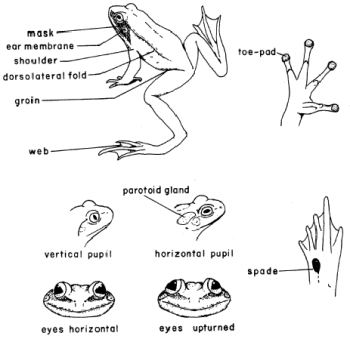Herpetofauna Identification Keys
A dichotomous key helps breakdown the identification process into steps. Each step contains a set of identification markers – choose the option that best fits your animal.
Try the key again if you don't think the species description matches, especially if you were unsure about some of your choices.
- Amphibian egg identification key (PDF, 2.4MB)
- Salamander identification key (PDF, 2.2MB)
- Snake identification key (PDF, 1.8MB)
- Turtle identification key (PDF, 3.3MB)
- Vancouver Island frog and toad identification key (PDF, 2.7MB)
Identification Key for Frogs & Toads
Step 1
- Pupil of eye vertical when contracted – go to step 2
- Pupil of eye horizontal when contracted – go to step 3
Step 2
- Sharp-edged, horny spade on underside of foot, body squat and toad-like
- No spade on sole of foot, male with tail-like copulatory organ
Step 3
- Parotoid glands and rough warts present, body squat
- No parotoid glands or warts present, skin smooth or with scattered tubercles – go to step 4
Step 4
- Conspicuous adhesive toe-pads present, dark eye stripe ending at shoulder
- Toe-pads absent or inconspicuous – go to step 5
Step 5
- Body elongated with dark side stripes extending to groin; three dorsal stripes or series of spots also present
- Dark side and dorsal stripes absent, dorsolateral folds and/or skin fold around ear membrane present – go to step 6
Step 6
- Large rounded spots with light halos present on a green or brown background, belly white, dorsolateral folds present
- No large, rounded spots on back – go to step 7
Step 7
- Colour green or olive green, no dark facial mask present. Adult males with deep yellow throats and ear membranes larger than diameter of eye – go to step 8
- Colour brown or tan, may have black, irregular spots on back, dark facial mask more or less obvious – go to step 9
Step 8
- Dorsolateral folds present
- Dorsolateral folds absent, skin fold around ear membrane present
Step 9
- Distinct, black facial mask present, no black dorsal spots, white belly, white mid-dorsal stripe may be present
- Red, orange or yellow colouration underneath, especially in older individuals, dark spots present on back, facial mask present but not intensely dark – go to step 10
Step 10
- Eye upturned, salmon colour on white background on belly and under legs, distinct dark spots on back, no green area in groin
- Eye not upturned, yellow or red underneath; red-coloured underparts, bones of lower leg may be visible through skin, area of green in groin
